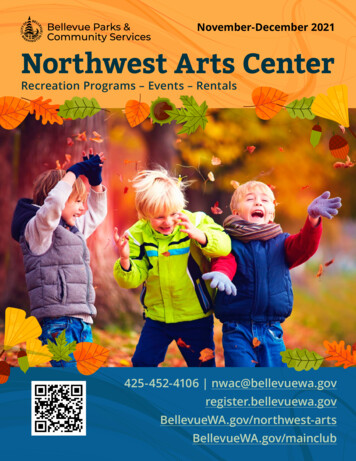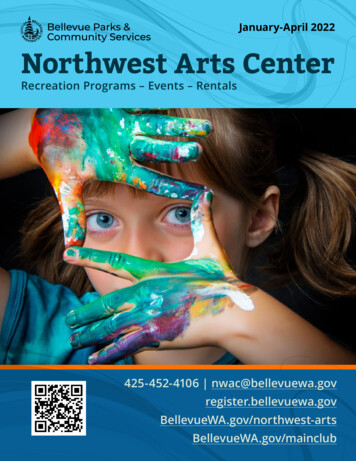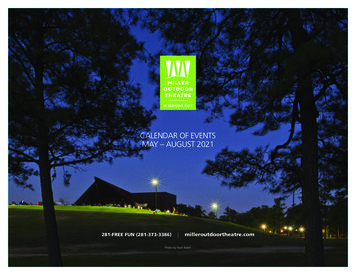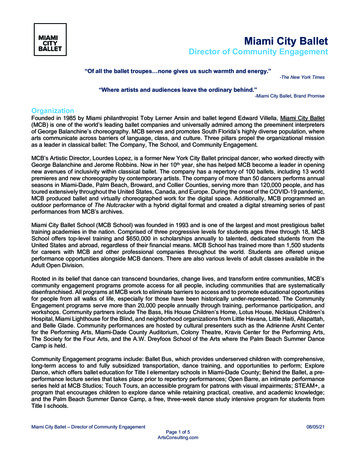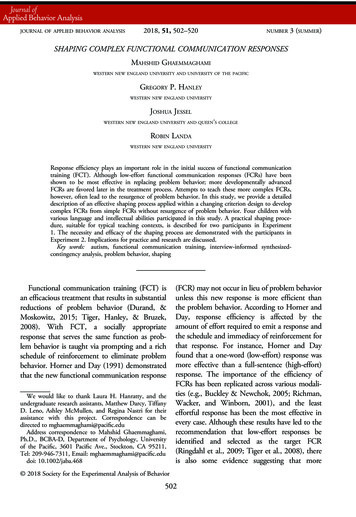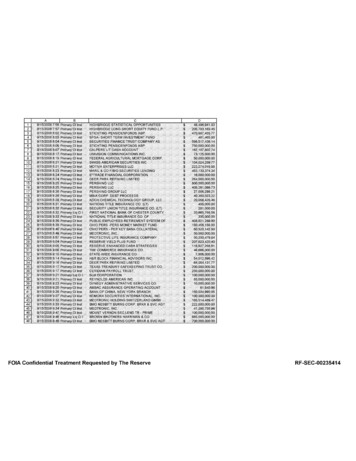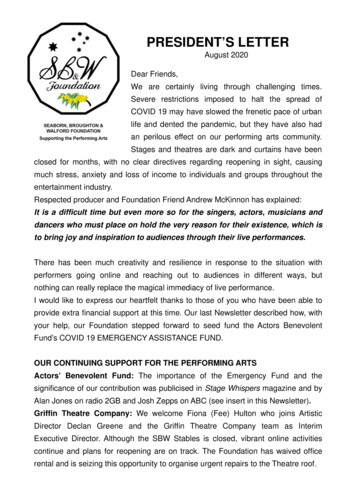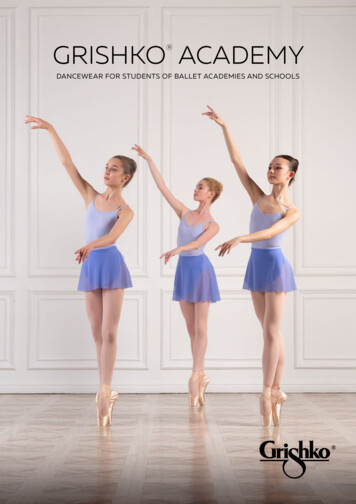
Transcription
Ballet BasicsAn Educational BookletforTeachers and StudentsPrepared by
BALLET BASICSBALLET HISTORYBallet began in Italy and France 400 years ago. The “Sun King”,King Louis XIV of France, began the first school of dance. This iswhy the official language of ballet is French.WHO DOES BALLET?In the beginning, ballet was only performed by royalty in thecourts of kings and queens. Now, people of all ages andbackgrounds learn ballet. Boys and girls around the world takeballet classes and dream of becoming famous dancers.DanceChance Level II students in the 33rd AnnualSchool PerformanceFormer PNB dancers Kaori Nakamura and Lucien Postelwaitein Kent Stowell’s Swan LakeIt takes ten years or more to become a professional dancer. Mostdancers start training when they are seven or eight years old.Dancers typically start auditioning for jobs in ballet companieswhen they graduate from high school or college.
BALLET AND SPORTSThere are many similarities between ballet and sports. Both dance andsports require strength, speed, balance, flexibility, and endurance.Male dancers have to bestrong to lift womenabove their head and dobig jumps and turns.Lesley Rausch and Karel Cruz with PNBCompany dancers and PNB School studentsin Ronald Hynd’s The Sleeping BeautyPNB Company dancers in Jerome Robbins’ Glass PiecesWomen must have strong ankles and feet towear pointe shoes. Often, dancers useIn ballet, andone liftof themosttocommonexercise machinesweightsbuildtheir strength and endurance.PNB Principal dancer Lindsi Dec
BALLET VOCABULARYIn ballet, one of the most commonmovements is called a plié [plee-AY].Plié means “to bend”.Rachel Foster and Kiyon Gaines inTwyla Tharp’s Opus 111Many athletes also use plié.Speed skaters plié to increasethe push of their legs and skatefaster.Basketball players must do a plié beforemaking a jump shot and while on defense.
Another commonstep that dancers do iscalled grand jeté[grahn zhuh-TAY],which means “bigthrow”.Angelica Generosa in Susan Stroman’sTAKE FIVE More or LessPNB Company dancers in Christopher Wheeldon’s PolyphoniaTrack and field athletesdo a similar type ofjump. Hurdlers jeté toleap over the hurdle ontheir course.
In ballet, grand battement [grahn bat-MAHN] means “largebeating” of the leg. It is a big kick with a straight leg and pointedfoot. Grand battement is very similar to the kick a football playerdoes to punt the ball for a field goal. Many professional footballplayers take ballet to help increase their flexibility andcoordination.Lesley Rausch in George Balanchine’s Agon The George Balanchine TrustSeattle Seahawks punter Jon RyanDo you think that you could do a grand battement like thesedancers are doing?Jerome Tisserand, Lindsi Dec, and Andrew Bartee in Ronald Hynd’s The Sleeping Beauty
BALLET IS AN ARTBallet and sports have many similarities. However, unlike sports,ballet is an art form. Dancers are able to tell a story, play acharacter, and communicate emotions with their dancing. Can youtell what the dancers are trying to communicate in the picturesbelow? Do their costumes give you any clues?Carla Körbes and Ezra Thomson in George Balanchine’s A Midsummer Night’s Dream The George Balanchine TrustPNB Company dancer with PNB School student in George Balanchine’s The Nutcracker , choreography by George Balanchine The Balanchine Trust
A TYPICAL BALLET CLASSAll dancers, including professionals, attendclasses to strengthen, stretch, and practicetechnique. Each class follows the sameformat. Class begins with the dancersholding onto a ballet barre, which givesthem extra balance. The instructor willdemonstrate and explain each exercise orcombination, and the dancers will repeat it,accompanied by music.DanceChance Level I girls at the barreBarre exercises start slowly with thedancer standing on both legs. Asbarre progresses and the dancers’bodies get warmer, the movementsbecome faster and more difficult,often including balances on one leg.DanceChance Level I boys balance on one leg at the barreAfter barre, class then moves to thecenter of the room where studentspractice turns and jumps.First‐year students will generallyspend one hour in class, two timesper week. As a dance studentimproves and develops a strongerbody, the number of classesrequired per week will increase.DanceChance Level I students practice jumps and turns in center
BALLET BASICS QUIZAnswer the following questions True or False.1)Professional dancers only train for 5 years.2)Ballet is an art form, not just a sport.3)Plié means “to jump”.4)Speed skaters do plié when they skate.5)Grand jeté means “big throw”.6)The official language of ballet is Russian.7)Hurdle jumpers do grand jeté.8)The “Sun King” of France began the first school of dance.9)Grand Battement means “to bend”.10)Men have to lift weights to be strong enough to lift otherdancers.We hope you had fun learning about ballet!(Answers on last page of packet)
RECOMMENDED Books, CD’s and DVD’s about DANCEBooks A Day in the Life of a Dancer, by Linda Hayward. London: Dorling Kindersley, 2001. 32 pages.Ages 4-9, grades preschool-4. Alvin Ailey, by Andrea Davis Pinkney. New York: Hyperion Books for Children, 1995. 32 pages.Ages 5-9. Ballerina, My Story, by Darci Kistler. New York: Minstrel, 1993. 128 pages. Ages 8-12. Ballet, by Kate Castle. New York: Kingfisher, 1996. 64 pages. Grades 4–6. Ballet Shoes, by Noel Streatfeild. New York: Random House, 1993. 256 pages. Ages 9-12. Coloring Book of Great Dancers, Santa Barbara: Bellerophon Books, 1989. Ages 9-11. Dance Me a Story, Twelve Tales from the Classical Ballets, by Jane Rosenberg. New York: Thames andHudson Inc., 1985. 127 pages. Ages 6-9, grades 3-6. Dancing in the Wings, by Debbie Allen. New York: Dial Books for Young Readers, 2000. 40 pages.Ages 4-8. Edgar Degas, Paintings that Dance, by Kristin N. Cole. New York: Grosset and Dunlap, 2001. 32pages. Ages 4-8, grades 1-3. Firebird by Misty Copeland. Putnam Juvenile, 2014. 40 pages. Ages 5-8. Katherine Dunham: Pioneer of Black Dance, by Barbara O'Connor. Carolrhoda Books, 2000. 104pages. Grades 5-8. Kids Dance, The Students of Ballet Tech, by Jim Varriale. New York: Dutton Children's Books, 1999.32 pages. Grades 3-6. My First Ballet Book, by Kate Castle. Kingfisher, 2006. 48 pages. Ages 4-8. Not Just Tutus, by Rachel Isadora. Putnam Juvenile, 2003. 40 pages. Ages 4-8, Grades K-4. Of Swans, Sugarplums and Satin Slippers, Ballet Stories for Children, by Violette Verdy. New York:Scholastic Inc., 1996. 80 pages. Ages 4-11. Pacific Northwest Ballet Presents Nutcracker, by Pacific Northwest Ballet Association. SasquatchBooks, 2005. 96 pages. Ages 3 & up.
Sleepless Beauty, by Frances Minters. Puffin, 1999. 32 pages. Ages 3–8. Stories from the Classical Ballet, by Belinda Hollyer. Pan Macmillan, 1996. 128 pages. Swan Lake, by Lisbeth Zwerger. North South Books, 2002. 32 pages. Grades 2-6. The Tale of the Firebird, by Gennady Spirin. Philomel, 2002. 32 pages. Ages 4-9, grades 2-5. The Young Person's Guide to the Ballet: With Music from The Nutcracker, Swan Lake, and The SleepingBeauty (Book & CD), by Anita Ganeri. London: Harcourt Brace and Company, 1998. 64 pages.Ages 9-12, grades 3-6.CDs & Music Tchaikovsky: Nutcracker (Favorite Excerpts from the Original Soundtrack Recording). LondonSymphony Orchestra-Charles Mackerras, Conductor. Telarc, 1990. Nutcracker: Complete Score. London Symphony Orchestra-Charles Mackerras, Conductor.Telarc, 1990. Tchaikovsky: Swan Lake, Montreal Symphony-Charles Dutoit, Conductor. Decca, 1994 Tchaikovsky Complete Tone Poems including Romeo & JulietDVDs & Videos PNB's A Midsummer Night's Dream, taped at Sadler's Wells Theatre, London, 1999. Sleeping Beauty: Royal BalletOnline Resources DanceChance information and ance/ Teacher Resources from PNB’s Community Education R KEY to Ballet Basics Quiz:1)F 2)T 3)F 4)T 5)T 6)F 7)T 8)T 9)F 10)T
BALLET VOCABULARY the push of their legs and skate Rachel Foster and Kiyon Gaines in Twyla Tharp’s Opus 111 In ballet, one of the most common movements is called a plié [plee-AY]. Plié means “to bend”.File Size: 1MB
